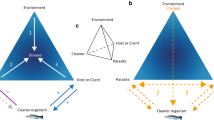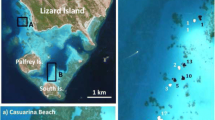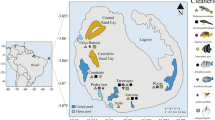Abstract
Cleaner fish remove parasites from other organisms, called clients. While there is an extensive body of work on the positive role of cleaners for their clients and reef communities, remarkably, potential parasites hosted by specialised cleaner fishes themselves have not been explored. In this study, we surveyed the parasite community of the Indo-Pacific cleaner wrasse Labroides dimidiatus, and compared it to other wrasses from the same region. L. dimidiatus was found to be infected by eight parasite groups including ectoparasites (copepods, isopods, trichodinids, monogeneans and turbellarians) and endoparasites (myxozoans, trematodes and cestodes) representing at least 12 species. The abundance and prevalence of most parasite groups was comparable to other wrasses, with the exception of bucephalid trematodes, which are not known to infect any other tropical wrasses except for Labroides species. This adds to mounting evidence that some parasite species exhibit atypical life cycles that exploit cleaning symbiosis. Particularly noteworthy was the discovery of gnathiid isopods on L. dimidiatus, which are generally considered the cleaner’s primary food item. Our findings provide new evidence for a potential role of wild cleaner fish as vectors of parasites to new clients, which highlights potential costs associated with cleaning symbiosis.



Similar content being viewed by others
Data availability
Data from this research is available at JCU Research Data Repository: https://doi.org/10.25903/hrzn-2564
Code availability
All data used, and R scripts are available at the JCU Research Data Repository: https://doi.org/10.25903/hrzn-2564
References
Barber I, Scharsack JP (2010) The three-spined stickleback-Schistocephalus solidus system: an experimental model for investigating host-parasite interactions in fish. Parasitology 137:411–424. https://doi.org/10.1017/S003118200999146
Becker JH, Grutter AS (2004) Cleaner shrimp do clean. Coral Reefs 23:515–520. https://doi.org/10.1007/s00338-004-0429-3
Binning SA, Roche DG, Grutter AS, Colosio S, Sun D, Miest J, Bshary R (2018) Cleaner wrasse indirectly affect the cognitive performance of a damselfish through ectoparasite removal. Proc R Soc B Biol Sci 285:20172447. https://doi.org/10.1098/rspb.2017.2447
Bronstein JL (2001a) The costs of mutualism. Am Zool 41:825–839. https://doi.org/10.1093/icb/41.4.825
Bronstein JL (2001b) The exploitation of mutualisms. Ecol Lett 4:277–287. https://doi.org/10.1046/j.1461-0248.2001.00218.x
Bshary R, Grutter AS (2002) Asymmetric cheating opportunities and partner control in a cleaner fish mutualism. Anim Behav 63:547–555. https://doi.org/10.1006/anbe.2001.1937
Bunkley-Williams L, Williams EH (1994) Diseases caused by Trichodina spheroidesi and Cryptocaryon irritans (Ciliophora) in wild coral reef fishes. J Aquat Anim Health 6:360–361. https://doi.org/10.1577/1548-8667(1994)006%3c0360:DCBTSA%3e2.3.CO;2
Caira JN, Reyda FB (2005) Eucestoda (true tapeworms). In: Rohde K (ed) Marine parasitology. CSIRO Publishing, Collingwood, pp 92–104
Clague GE, Newport C, Grutter AS (2011a) Intraspecific cleaning behaviour of adult cleaner wrasse, Labroides dimidiatus (Perciformes: Labridae). Mar Biodivers Rec 4:8–10. https://doi.org/10.1017/S175526721100056X
Clague GE, Cheney KL, Goldizen AW, McCormick MI, Waldie PA, Grutter AS (2011b) Long-term cleaner fish presence affects growth of a coral reef fish. Biol Lett 7:863–865. https://doi.org/10.1098/rsbl.2011.0458
Cribb TH, Bray RA (2010) Gut wash, body soak, blender and heat-fixation: approaches to the effective collection, fixation and preservation of trematodes of fishes. Syst Parasitol 76:1–7. https://doi.org/10.1007/s11230-010-9229-z
Deady S, Varian SJA, Fives JM (1995) The use of cleaner-fish to control sea lice on two Irish salmon (Salmo salar) farms with particular reference to wrasse behaviour in salmon cages. Aquaculture 131:73–90. https://doi.org/10.1016/0044-8486(94)00331-H
Dunkley K, Ward AJW, Perkins SE, Cable J (2020) To clean or not to clean : cleaning mutualism breakdown in a tidal environment. Ecol Evol. https://doi.org/10.1002/ece3.6120
Dyer WG, Williams EH, Bunkley-Williams L (1988) Digenetic trematodes of marine fishes of Okinawa, Japan. J Parasit 74:638–645. https://doi.org/10.2307/3282183
Erkinharju T, Dalmo RA, Hansen M, Seternes T (2020) Cleaner fish in aquaculture: review on diseases and vaccination. Rev Aquacult. https://doi.org/10.1111/raq.12470
Feder HM (1966) Cleaning symbiosis in the marine environment. Symbiosis 1:327–380
Franceschi N, Rigaud T, Moret Y, Hervant F, Bollache L (2007) Behavioural and physiological effects of the trophically transmitted cestode parasite, Cyathocephalus truncatus, on its intermediate host, Gammarus pulex. Parasitology 134:1839–1847. https://doi.org/10.1017/S0031182007003228
Francini-Filho RB, Moura RL, Sazima I (2000) Cleaning by the wrasse Thalassoma noronhanum, with two records of predation by its grouper client Cephalopholis fulva. J Fish Biol 56:802–809. https://doi.org/10.1006/jfbi.1999.1197
Gabagambi NP, Salvanes AGV, Midtøy F, Skorping A (2019) The tapeworm Ligula intestinalis alters the behavior of the fish intermediate host Engraulicypris sardella, but only after it has become infective to the final host. Behav Process 158:47–52. https://doi.org/10.1016/j.beproc.2018.11.002
Grutter A (1996) Parasite removal rates by the cleaner wrasse Labroides dimidiatus. Mar Ecol Prog Ser 130:61–70. https://doi.org/10.3354/meps130061
Grutter A (1999) Cleaner fish really do clean. Nature 398:672–673. https://doi.org/10.1038/19443
Grutter A (2002) Cleaning symbioses from the parasites’ perspective. Parasitology 124:65–81. https://doi.org/10.1017/S0031182002001488
Grutter AS (2004) Cleaner fish use tactile dancing behavior as preconflict management strategy. Curr Biol 128:189–190. https://doi.org/10.1016/j.cub.2004.05.048
Grutter AS, Amon A, Green AL, Vaughan D (2020) Clownfish Amphiprion polymnus wound cleaned by Ancylomenes sp. cleaner shrimp. Galaxea 22:7–8. https://doi.org/10.3755/galaxea.22.1_7
Hobson ES (1971) Cleaning symbiosis among California inshore fishes. Fish Bull 69(3):491–523
Hutson KS, Brazenor AK, Vaughan DB, Trujillo-González A (2018) Monogenean parasite cultures: current techniques and recent advances. Adv Parasitol 99:61–91. https://doi.org/10.1016/bs.apar.2018.01.002
Jensen K, Bullard SA (2010) Characterization of a diversity of tetraphyllidean and rhinebothriidean cestode larval types, with comments on host associations and life-cycles. Int J Parasitol 40:889–910. https://doi.org/10.1016/j.ijpara.2009.11.015
Jones CM, Grutter AS, Cribb TH (2003) Rhipidocotyle labroidei n. sp. (Digenea: Bucephalidae) from Labroides dimidiatus (Valenciennes) (Labridae). Zootaxa 327:1–5. https://doi.org/10.11646/zootaxa.327.1.1
Jones CM, Grutter AS, Cribb TH (2004) Cleaner fish become hosts: a novel form of parasite transmission. Coral Reefs 23:521–529. https://doi.org/10.1007/s00338-004-0411-0
Kearn GC (2005) Leeches, lice and lampreys: a natural history of skin and gill parasites of fishes. Springer, Dordrecht
Lafferty KD (1999) The evolution of trophic transmission. Parasitol Today 15:111–115. https://doi.org/10.1016/S0169-4758(99)01397-6
Lobel PS (1976) Predation on a cleanerfish (Labroides) by a hawkfish (Cirrhites). Copeia 1976:384–385. https://doi.org/10.2307/1443970
Lom J, Dyková I (1992) Protozoan parasites of fishes. Elsiever, Amsterdam, London, New York, Tokyo
Marcogliese DJ (1995) The role of zooplankton in the transmission of helminth parasites to fish. Rev Fish Biol Fish 5:336–371. https://doi.org/10.1007/BF00043006
Messias JPM, Soares MC (2015) When good advertisement backfires: cleaners get eaten too. Coral Reefs 34:1279. https://doi.org/10.1007/s00338-015-1303-1
Muñoz G, Cribb TH (2005) Infracommunity structure of parasites of Hemigymnus melapterus (Pisces: Labridae) from Lizard Island, Australia: the importance of habitat and parasite body size. J Parasitol 91:38–44. https://doi.org/10.1645/ge-3321
Muñoz G, Cribb TH (2006) Parasite communities and diet of Coris batuensis (Pisces: Labridae) from Lizard Island, Great Barrier Reef. Mem Queensl Museum 52:191–198
Muñoz G, Grutter AS, Cribb TH (2007) Structure of the parasite communities of a coral reef fish Assemblage (Labridae): testing ecological and phylogenetic host factors. J Parasitol 93:17–30. https://doi.org/10.1645/GE-969R.1
Muñoz G, Valdivia I, López Z (2015) The life cycle of Prosorhynchoides carvajali (Trematoda: Bucephalidae) involving species of bivalve and fish hosts in the intertidal zone of central Chile. J Helminthol 89:584–592. https://doi.org/10.1017/S0022149X14000546
Nagel L, Grutter AS (2007) Host preference and specialization in Gnathia sp., a common parasitic isopod of coral reef fishes. J Fish Biol 70:497–508. https://doi.org/10.1111/j.1095-8649.2007.01320.x
Narvaez P, Vaughan DB, Grutter AS, Hutson KS (2021) New perspectives on the role of cleaning symbiosis in the possible transmission of fish diseases. Rev Fish Biol Fish. https://doi.org/10.1007/s11160-021-09642-2
Omrani SB, Mousavi HA, Sharifpour I (2010) Occurrence and histopathology of Ascocotyle tenuicollis metacercaria in gill of platyfish (Xiphophorus maculatus) imported to Iran. Iran J Fish Sci 9:472–477
Poulin R (2010) Parasite manipulation of host behavior: an update and frequently asked questions. Adv Study Behav 41:151–186. https://doi.org/10.1016/S0065-3454(10)41005-0
R Core Team (2020) R: a language and environment for statistical computing. R Foundation for Statistical Computing, Vienna, Austria. https://www.R-project.org/. Aug 2020
Ritchie G (1997) The host transfer ability of Lepeophtheirus salmonis (Copepoda: Caligidae) from farmed Atlantic salmon, Salmo salar L. J Fish Dis 20:153–157. https://doi.org/10.1046/j.1365-2761.1997.00285.x
Robertson R (1974) A study of the ethology and reproductive biology of the labrid fish, Labroides dimidiatus at Heron Island, Great Barrier Reef. PhD thesis, University of Queensland
Roberts-Thomson A, Bott NJ (2007) Exploiting mimicry: Prosorhynchoides thomasi n. sp. (Digenea: Bucephalidae) from the fang blenny genus Plagiotremus (Bleeker) (Blenniidae) from off Lizard Island on the Great Barrier Reef, Australia. Zootaxa 1514:61–64. https://doi.org/10.11646/zootaxa.1514.1.3
Rohde K (2005) Marine parasitology. CSIRO Publishing, Melbourne and CABI Publishing, Wallingford, Oxon, p 565
Russell BC, Allen GR, Lubbock HR (1976) New cases of mimicry in marine fishes. J Zool 180:407–423. https://doi.org/10.1111/j.1469-7998.1976.tb04685.x
Sakanari JA, Moser M (1989) Complete life cycle of the elasmobranch cestode, Lacistorhynchus dollfusi Beveridge and Sakanari, 1987 (Trypanorhyncha). J Parasitol 75:806–808. https://doi.org/10.2307/3283069
Sikkel PC, Richardson MA, Sun D, Narvaez P, Feeney WE, Grutter AS (2019) Changes in abundance of fish-parasitic gnathiid isopods associated with warm-water bleaching events on the northern Great Barrier Reef. Coral Reefs 38:721–730. https://doi.org/10.1007/s00338-019-01835-3
Skilton DC, Saunders RJ, Hutson KS (2020) Parasite attractants: identifying trap baits for parasite management in aquaculture. Aquaculture 516:734557. https://doi.org/10.1016/j.aquaculture.2019.734557
Slavík O, Horký P, Douda K, Velíšek J, Kolářová J, Lepič P (2017) Parasite-induced increases in the energy costs of movement of host freshwater fish. Physiol Behav 171:127–134. https://doi.org/10.1016/j.physbeh.2017.01.010
Soares MC, Oliveira RF, Ros AFH, Grutter AS, Bshary R (2011) Tactile stimulation lowers stress in fish. Nat Commun 2:534–535. https://doi.org/10.1038/ncomms1547
Stanton ML, Palmer TM (2011) The high cost of mutualism: Effects of four species of East African ant symbionts on their myrmecophyte host tree. Ecology 92:1073–1082. https://doi.org/10.1890/10-1239.1
Sun D, Cheney KL, Werminghausen J, Meekan MG, McCormick MI, Cribb TH, Grutter AS (2015) Presence of cleaner wrasse increases the recruitment of damselfishes to coral reefs. Biol Lett 11:20150456. https://doi.org/10.1098/rsbl.2015.0456
Tully O, Daly P, Lysaght S, Deady S, Varian SJA (1996) Use of cleaner-wrasse (Centrolabrus exoletus (L.) and Ctenolabrus rupestris (L.)) to control infestations of Caligus elongatus Nordmann on farmed Atlantic salmon. Aquaculture 142:11–24. https://doi.org/10.1016/0044-8486(95)01245-1
Vaughan DB, Grutter AS, Costello MJ, Hutson KS (2017) Cleaner fishes and shrimp diversity and a re-evaluation of cleaning symbioses. Fish Fish 18:698–716. https://doi.org/10.1111/faf.12198
Vaughan DB, Grutter AS, Ferguson HW, Jones R, Hutson KS (2018) Cleaner shrimp are true cleaners of injured fish. Mar Biol 165:118. https://doi.org/10.1007/s00227-018-3379-y
Waldie PA, Blomberg SP, Cheney KL, Goldizen AW, Grutter AS (2011) Long-term effects of the cleaner fish Labroides dimidiatus on coral reef fish communities. PLoS ONE 6(6):e21201. https://doi.org/10.1371/journal.pone.0021201
Wang Y, Naumann U, Wright ST, Warton DI (2012) Mvabund—An R package for model-based analysis of multivariate abundance data. Methods Ecol Evol 3:471–474. https://doi.org/10.1111/j.2041-210X.2012.00190.x
Warton DI, Wright ST, Wang Y (2012) Distance-based multivariate analyses confound location and dispersion effects. Methods Ecol Evol 3:89–101. https://doi.org/10.1111/j.2041-210X.2011.00127.x
Yong RQ-Y, Cutmore SC, Jones MK, Gauthier ARG, Cribb TH (2018) A complex of the blood fluke genus Psettarium (Digenea: Aporocotylidae) infecting tetraodontiform fishes of eastern Queensland waters. Parasitol Int 67:321–340. https://doi.org/10.1016/j.parint.2017.12.003
Acknowledgements
We thank Alexia Dubuc for assistance in the field. We thank David Vaughan, Alejandro Trujillo González, Katie Motson, Geoffrey Boxshall, Jean-Lou Justine and Marlies Monnens for support with parasite identification. We thank Renato Morais for his assistance with statistical analyses and for helpful comments on the manuscript and Gabriela Muñoz for sharing data for comparison with other labrids. The authors also wish to thank Mark McCormick for financial support and the staff of Lizard Island Research Station for their constant technical support. We thank Eden Cartwright, Bird Circus, for assistance with Fig. 1. The authors acknowledge the Dingaal and Quandamooka people, the traditional owners and custodians of the land and country upon which this research was carried out, and pay respects to elders past and present of those nations.
Funding
James Cook University Postgraduate Research Scholarship (JCUPRS) to PN. The University of Queensland to ASG.
Author information
Authors and Affiliations
Contributions
PN, KSH, ASG and RQY designed the study. PN and RQY collected the data. PN analysed the data and wrote the paper. All authors contributed to drafting and editing.
Corresponding author
Ethics declarations
Conflicts of interest
The authors declare that they have no conflict of interest.
Ethics approval
This research was approved by James Cook University Animal Ethics Committee (permit number A2558) and The University of Queensland (permit number UQ SIB/837/07).
Consent to participate
All the authors have provided their consent to participate in this study.
Consent for publication
All listed authors have approved the manuscript before submission.
Additional information
Responsible Editor: T. Reusch.
Publisher's Note
Springer Nature remains neutral with regard to jurisdictional claims in published maps and institutional affiliations.
Reviewers: J. Scharsack and an undisclosed expert.
Rights and permissions
About this article
Cite this article
Narvaez, P., Yong, R.QY., Grutter, A.S. et al. Are cleaner fish clean?. Mar Biol 168, 59 (2021). https://doi.org/10.1007/s00227-021-03858-3
Received:
Accepted:
Published:
DOI: https://doi.org/10.1007/s00227-021-03858-3




